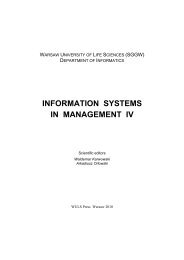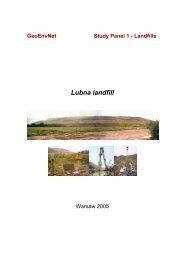ACTA SCIENTIARUM POLONORUM - SGGW
ACTA SCIENTIARUM POLONORUM - SGGW
ACTA SCIENTIARUM POLONORUM - SGGW
Create successful ePaper yourself
Turn your PDF publications into a flip-book with our unique Google optimized e-Paper software.
162 M. ŻakNOWADAYS SOCIAL ACTIVITY OF RURAL WOMEN IN POLANDRural women undertake social activity for local environment more willingly than menor women living in towns. Moreover, they become councilors, chairs of village councilsand take part in creating local activity groups.[Psyk-Piotrowska 2008]The increase of rural woman’s social activity is connected with Poland’s accession tothe European Union. It is the result of necessity to institutionalize the cooperation of public,economic and social sector. Therefore various trainings, workshops, conferences areorganized and the principles how to finance the activities and control finances are established[Fuszara 2008]. The organizations wishing to undertake such an activity must havea legal personality. This phenomenon may also be considered in the context of changes inthe Polish women’s movement in general. The issue of qualitative changes in the Polishwomen’s movement resulting from the accession of Poland to the European Union wastaken up by M. Fuszara who claimed that rural women’s organizations, which are activenowadays, are the organizations of women, not only for women [Fuszara 2007].The most widespread rural women’s activity is the activity in village women’s clubs,which are, by definition, “voluntary, self-governed, independent, apolitical, social andprofessional organizations of rural women” [Grzebisz-Nowicka 1999]. The village women’sclubs are treated by the act of 1982 as the organizational units of agricultural circles.Therefore they have never been and are not independent organizations.Some of village women’s clubs functioning on the basis of the act of 1982 on social-professionalorganizations of farmers evolve into associations which function on thebasis of the act of April 7 th , 1989 The Associations Act [the Journal of Laws of the Republicof Poland of 1989 No. 20 item 104 as amended]. Additionally they would like toobtain the status of public benefit organization which means they have to comply with theprovisions of the act of April 24 th , 2003 on Public Benefit and Volunteer Work [the Journalof Laws of the Republic of Poland of 2003, No. 96 item 873 as amended] [Raszeja-Ossowska, Formalno-prawne... 2010].There are various organizational forms of village women’s clubs which function nowadays:village women’s club functioning as organizational entity of a farming circle, as anindependent farming circle, as an association (ordinary or registered) [Raszeja-Ossowska,Źródła... 2010]. Apart from the types of rural women’s organizations mentioned above,the new associations of women also come into being. They conduct similar activity to theactivity of the organizations described above.Having a legal personality enables participation in competitions for projects implementedwithin the scope of activities financed from the European Union’s budget withparticipation of state financial resources (including the Leader program) as well as applyingfor grants from non-governmental organizations and local government authorities.Maria Majocha, the president of the Association Village Women’s Club “Osada” inOtałęż in Podkarpackie Region, suggested such a solution for the organization she led:“As a result of transformation of the village women’s club into an association we are ableapply for money necessary to implement various projects. Thanks to the registration, theorganization has an entry in the National Court Register and National Business RegistryNumber (REGON). Without them we could not apply for money from the EU. It is alsoeasier to apply for grants from various organizations and subsidies from the communalbudget” [Interview 2].Acta Sci. Pol.
















